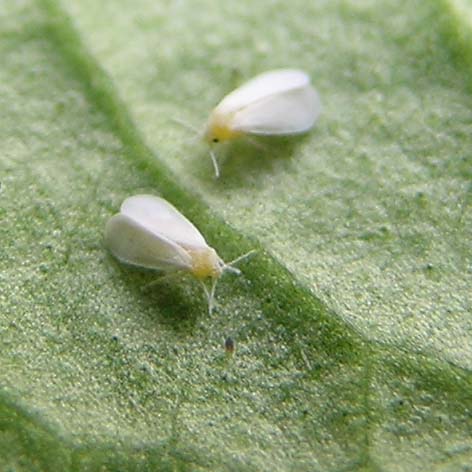 |
| Adult whiteflies (photo from Wikipedia) |
We have two verbena plants. One is in a pot with a tomato and oregano while the other is in a pot by itself. We noticed something was amiss when the plant in the mixed pot was flowering while the one by itself started to languish. We also noticed that the bottom of some leaves were covered in black spots. Curiosity turned into dread. These little flies were no good.
These flies, called whiteflies, are a common pest in most types of gardens. Sadly for container gardeners in Puerto Rico these flies thrive in hot weather. There are two common types of whiteflies: the greenhouse whitefly (Trialeurodes vaporariorum) and the silverleaf whitefly (Bernisia sp.). Whiteflies lay small, oblong eggs on the underside of leaves. They go through four nymphal stages with the final stage being the flying adult. Through all stages they feed on plant juices which weakens the plant. They excrete a substance called honeydew which as its name suggests is sweet and sticky. Ants love this stuff. If you see many ants in your plant you may have an infestation of whiteflies or aphids (Editors note:Always follow the ants. They'll lead you straight to the problem.). Besides weakening your plants whiteflies are capable of transmitting viruses such as tomato yellow leaf curl. They also cause leaves to develop a black sooty fungus.
Controlling whitefly populations is difficult. They are usually resistant to most insecticides. The best approach is prevention. Carefully observe your plants every day for signs of weakness, yellowing or emergence of eggs. Removing affected leaves or plants will ensure control of whitefly populations. If you are past prevention (as we are) there are several things you may try.
- Vacuuming adults early in the morning when it is still cold. Use a small hand vacuum to avoid damaging your plants. Place vacuumed flies in the freezer to kill them off.
- Application of an organic insecticide soap will kill some flies.
- Yellow sticky traps will attract flies. These traps can be used to monitor and control populations.
- Natural predators. Ladybug larvae, Green Lacewing, predatory mites and some birds are known to kill whiteflies.
0 comments:
Post a Comment